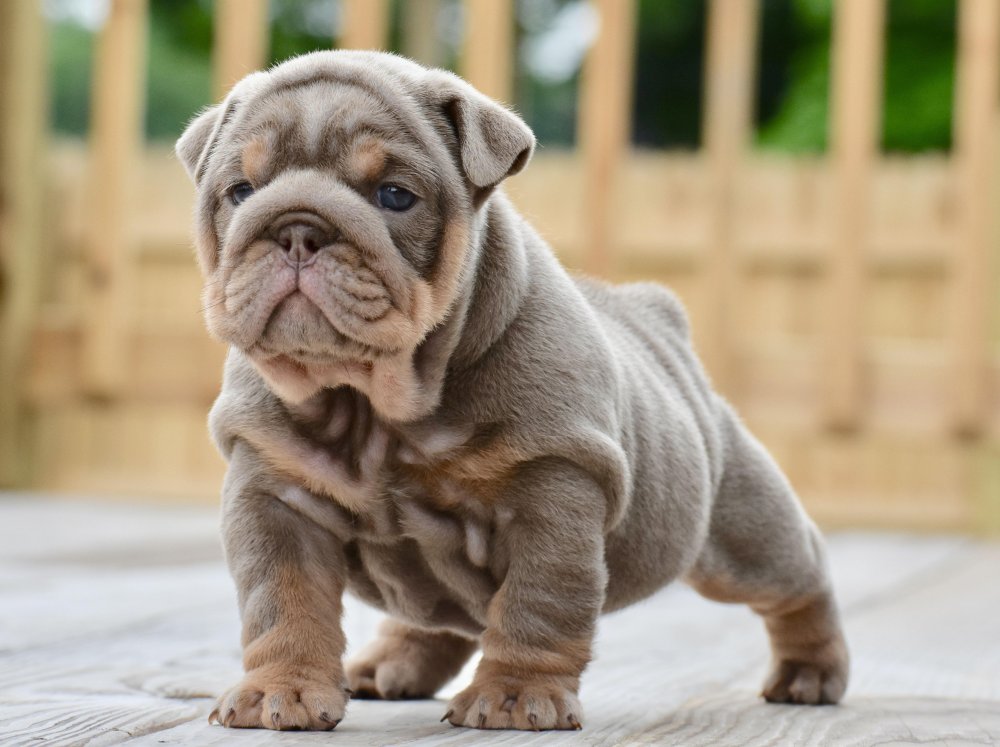- Breed Category: Non-sporting group
- Country of Origin: England
- Average Height: 31-40 cm; 12-16 inches
- Average Weight: Males 23-25 kg; Females 18-23 kg
- Average Life Span: 8-10 years
- Grooming Requirements: Low; occasional brushing needed
- Exercise Requirements: Moderate; daily short walks
- Coat Type: Short and smooth
- Coat Color Variations: Brindle, white, fawn, red
- Shedding Level: Moderate
- Ear Type: Rose-shaped
- Tail Type: Straight or screwed
- Temperament: Gentle, affectionate, courageous
- Intelligence Level: Average
- Barking Tendency: Low
- Compatibility with Children: High; very good with kids
- Compatibility with Other Pets: Generally good
- Training Ease: Moderate; can be stubborn
- Common Health Issues: Respiratory problems, hip dysplasia
- Dietary Needs: Balanced diet; avoid overfeeding
- Energy Level: Low to moderate
- Drooling Tendency: High
- Sensitivity to Weather: Sensitive to heat
- Overall Maintenance Level: Moderate
- Original Purpose: Bull-baiting
- Year of Recognition by Kennel Clubs: 1873
- Famous Breed Representatives: Churchill’s mascot, “Bulldog”
- Apartment Friendly: Yes, suitable for apartments
- Best Suited For: Families, singles, city living
- Cost of Ownership: Moderate to high
- Unique Traits: Distinctive wrinkled face
- Cultural Significance: Symbol of British tenacity
- Popularity Rank: High; consistently popular
Imagine a dog with a face full of character, a sturdy build, and a heart as big as its body. That’s the Bulldog for you. Known for their distinctive wrinkled face and pushed-in nose, Bulldogs are a breed that stands out in a crowd. Originally bred in England for bull-baiting, these dogs have a rich history that has shaped their unique appearance and temperament. Today, Bulldogs are cherished companions, known for their gentle and affectionate nature. This article aims to delve into the fascinating world of Bulldogs, exploring their characteristics, historical background, and the care they require. Whether you’re considering bringing one into your home or simply curious, there’s much to learn about this remarkable breed.
History and Origin of the Bulldog Breed

Early Development of the Bulldog Breed
The Bulldog’s journey began in England, where it was initially bred for a rather grim purpose. These dogs were developed for bull-baiting, a popular but brutal sport in the 13th century. Bulldogs of that era were much more ferocious and athletic than the lovable companions we know today. Their muscular build and tenacity made them perfect for the task.
Role in Bull-Baiting and Transition to Companion Animal
As bull-baiting was outlawed in 1835, the Bulldog faced a crossroads. Rather than fading into history, breeders began to focus on their gentler traits. Over time, the breed was refined to become the affectionate and loyal companion we cherish today. This transformation is a testament to the breed’s adaptability and the dedication of its enthusiasts.
Key Historical Figures and Events in the Breed’s Evolution
One pivotal figure in the Bulldog’s evolution was Bill George, a 19th-century breeder who played a significant role in reshaping the breed’s temperament. His efforts, along with others, helped transition the Bulldog from a fighter to a family pet. The breed’s journey from bull-baiting arenas to living rooms is a fascinating chapter in canine history.
Physical Characteristics of the Bulldog

Appearance
Bulldogs are medium-sized dogs with a compact, muscular build. They typically weigh between 18 to 23 kilograms, making them sturdy yet manageable. Their coat is short and smooth, coming in a variety of colours like brindle, white, fawn, and piebald. One of the most striking features is their wrinkled face, which gives them a unique expression. These wrinkles, along with their pushed-in nose, make them instantly recognisable.
Unique Physical Traits
Beyond their iconic face, Bulldogs have a stocky build and a low-slung body. Their broad shoulders and wide-set legs give them a distinctive gait. Despite their somewhat intimidating appearance, their eyes often convey a gentle and friendly demeanour. Another notable trait is their underbite, which adds to their charming, slightly comical look. These physical characteristics not only make Bulldogs stand out but also contribute to their endearing personality.
Temperament and Behaviour of Bulldogs

Typical Personality Traits
Bulldogs are known for their loyalty and gentleness, making them a favourite among dog lovers. They have a calm and laid-back nature, which is perfect for those who prefer a more relaxed companion. However, they can be a bit stubborn at times, which adds a touch of character to their personality. This stubborn streak means they might need a bit of patience during training, but their eagerness to please often wins out in the end.
Suitability as a Family Pet and Companion
As family pets, Bulldogs are hard to beat. Their affectionate nature makes them excellent companions for people of all ages. They thrive on human interaction and are happiest when they’re part of the family activities. Their moderate energy levels mean they enjoy a good play session but are equally content to lounge around the house.
Interaction with Children and Other Animals
Bulldogs are generally great with children, displaying a protective yet gentle demeanour. They are patient and tolerant, making them ideal playmates for kids. When it comes to other animals, Bulldogs usually get along well, especially if they’re socialised from a young age. Their friendly nature often extends to other pets, creating a harmonious household environment.
Training and Exercise Needs for Bulldogs

Importance of Early Training and Socialisation
Getting a Bulldog off to a good start with early training and socialisation is crucial. These early experiences shape their behaviour and temperament, helping them grow into well-adjusted adults. Bulldogs can be a bit stubborn, so starting young helps set the foundation for a well-behaved companion. Socialising them with different people, environments, and other animals ensures they become friendly and confident.
Recommended Training Techniques for Bulldogs
When it comes to training Bulldogs, patience and consistency are key. Positive reinforcement works wonders with this breed. They respond well to treats, praise, and play as rewards for good behaviour. Short, engaging training sessions keep their attention and prevent boredom. Remember, Bulldogs have a sensitive side, so harsh methods can be counterproductive.
Exercise Requirements and Activities They Enjoy
Bulldogs aren’t the most energetic breed, but they still need regular exercise to stay healthy. A couple of short walks each day, along with some playtime, usually does the trick. They enjoy activities like fetch or a gentle tug-of-war. Just be mindful of their breathing, especially in hot weather, as their unique facial structure can make them prone to overheating.
Health and Lifespan of Bulldogs

Common Health Issues
Bulldogs, with their unique build and features, are prone to certain health issues. Breathing problems are common due to their short snouts, making them susceptible to conditions like brachycephalic obstructive airway syndrome. Skin infections can occur in their wrinkles if not cleaned regularly. Hip dysplasia and joint issues are also concerns, given their stocky build.
Average Lifespan and Health Tips
On average, Bulldogs live between 8 to 10 years. To help them reach the upper end of this range, a balanced diet and regular vet check-ups are essential. Keeping them at a healthy weight reduces stress on their joints and helps prevent obesity-related issues. Regular, gentle exercise is key, but always be mindful of their breathing, especially in warmer weather.
Preventative Care Recommendations
- Regular vet visits for vaccinations and health screenings.
- Daily cleaning of facial wrinkles to prevent infections.
- Maintain a balanced diet to support overall health.
- Monitor their weight to avoid obesity-related problems.
- Provide a cool, comfortable environment to prevent overheating.
Grooming and Maintenance for Bulldogs

Coat Care and Grooming Routines
Bulldogs have a short, smooth coat that’s relatively easy to maintain. Regular brushing, about once a week, helps keep their coat healthy and reduces shedding. A soft-bristle brush or a rubber grooming mitt works well to remove loose hair and distribute natural oils, keeping their skin and coat in top condition.
Shedding and Seasonal Grooming Tips
While Bulldogs aren’t heavy shedders, they do experience seasonal shedding, usually in spring and autumn. During these times, you might need to brush them more frequently to manage the extra hair. Bathing them every few months or as needed helps keep their coat clean, but be sure to use a gentle dog shampoo to avoid skin irritation.
Don’t forget those adorable wrinkles! Regularly clean and dry the folds on their face to prevent moisture build-up and potential infections. A damp cloth followed by a dry one usually does the trick. Keeping up with these simple grooming routines ensures your Bulldog stays comfortable and looking their best all year round.
Diet and Nutrition for Bulldogs
Nutritional Needs for Optimal Health
Bulldogs have specific dietary needs to keep them healthy and happy. A balanced diet rich in high-quality proteins, healthy fats, and essential vitamins and minerals is crucial. Look for dog food that lists meat as the first ingredient, ensuring they get the protein they need for muscle maintenance and energy.
Foods to Include and Avoid
Include lean meats, fish, and vegetables in their diet. These provide essential nutrients and help maintain a healthy weight. Avoid foods high in fillers, artificial additives, and excessive grains, as these can lead to allergies and digestive issues. Also, steer clear of chocolate, onions, and grapes, which are toxic to dogs.
Feeding Schedules and Portion Recommendations
Establishing a consistent feeding schedule helps regulate their metabolism and prevent overeating. Typically, feeding them twice a day works well. Portion sizes depend on their age, weight, and activity level, so it’s best to consult with your vet for tailored advice. Keep an eye on their weight and adjust portions as needed to maintain a healthy physique.
Fun Facts and Trivia about Bulldogs

Interesting Tidbits about the Bulldog Breed
Did you know that Bulldogs are one of the most popular dog breeds in Australia? Their unique appearance and charming personality make them a favourite among dog lovers. Despite their tough look, Bulldogs are known for their gentle and affectionate nature. They are also quite the couch potatoes, preferring a relaxed lifestyle over high-energy activities.
Bulldogs have a fascinating history. They were originally bred for bull-baiting, a sport that was banned in the 19th century. This led to a transformation in their temperament, making them the lovable companions we know today. Their distinctive wrinkled face and pushed-in nose are not just for show; these features were originally developed to help them breathe while holding onto a bull.
Famous Bulldogs in Media or History
Bulldogs have made their mark in media and history. One of the most famous Bulldogs is “Spike” from the classic cartoon “Tom and Jerry.” His tough exterior and soft heart perfectly capture the breed’s essence. In history, Winston Churchill, the British Prime Minister during World War II, was often compared to a Bulldog for his tenacity and determination, further cementing the breed’s iconic status.
Final Thoughts

Bulldogs are a unique blend of charm and resilience. Their journey from bull-baiting arenas to beloved family companions highlights their adaptability and enduring appeal. Despite their health challenges, Bulldogs offer unmatched loyalty and affection, making them ideal pets for many households. Embracing a Bulldog means welcoming a gentle, courageous friend into your life, ready to share in your daily adventures. Consider adopting a Bulldog to experience the joy and companionship they bring.
